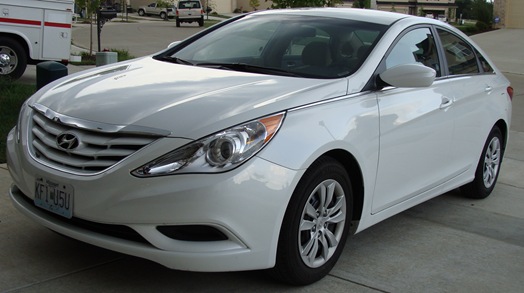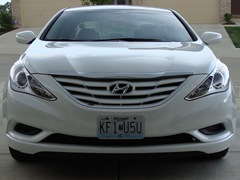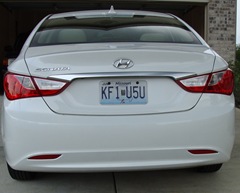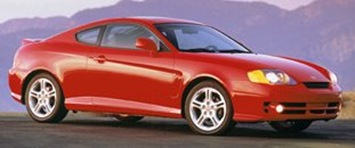It’s nice to be able to drive a different car once in a while and when that opportunity comes, you have to jump on it, right? Well, that time came a couple of weeks ago and the vehicle we got to drive was the new-for-2011 Hyundai Sonata.
I haven’t driven too many Hyundai cars in the past. The one that sticks out is the Tiburon GT I drove in 2003 (see review below), when Hyundai was finally on a roll with good quality and spectacular styling.
Today, Hyundai is known for putting out a great product, in both quality and appearance, and at a lower price than the competition. Add to the above a long list of standard features and you have a well-rounded vehicle with cutting edge technology, great looks and a great price.
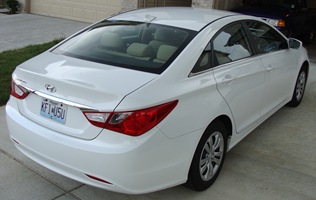 Let’s start with a look at the new Sonata’s styling. What you get is organic design with a whole lot of character which makes this new Sonata stand out amongst the crowd of standard, mainstream sedans.
Let’s start with a look at the new Sonata’s styling. What you get is organic design with a whole lot of character which makes this new Sonata stand out amongst the crowd of standard, mainstream sedans.
The front end features a tiered grill, elongated headlights and a double-creased hood the looks like nothing else out there today. Along the sides you get a rising character line and a chrome accent line the runs form the headlights to the trailing edge of the rear quarter windows. Again, unlike anything else out there today. the rear end treatment is quite lexus-esque and has been compared with the look of Mercedes Benz.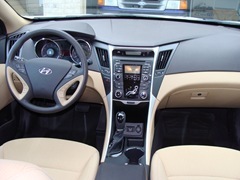
The swoopy arcs and complex facets also reside in the interior. The two-tone treatment lends an air of class and sophistication for this inexpensive car and makes it much more interesting to look at.
The instrument panel is a piece of art. the gauges, with gauges embedded with gauges look is quite impressive and the cool blue lighting, reminiscent of the VW Jetta, is easy on the eyes, easy to read and just looks plain cool.
 On the tech front, all Sonatas come with AM/FM/XM/CD/MP3 audio system with 6 speakers, Bluetooth connectivity for hands-free calling and iPod®/USB and auxiliary input jacks in case you can’t find anything on XM to listen to.
On the tech front, all Sonatas come with AM/FM/XM/CD/MP3 audio system with 6 speakers, Bluetooth connectivity for hands-free calling and iPod®/USB and auxiliary input jacks in case you can’t find anything on XM to listen to.
The seats in our low-level GLS were actually quite comfortable but the fabric covering them, in striking beige, looked like they might wear out prematurely and definitely show stains easily.
At this point, all Sonatas come with only one engine, a 2.4-liter direct injected four-cylinder with 200 horsepower and and 186 ft.-lbs. of torque. We got 35 miles per gallon in mostly highway driving during our short visit. That figure was helped, in part, by the six-speed automatic transmission our car had. Granted, the only Sonata that has a manual tranny, a six-speed as well, is the base GLS.
On the highway, Sonata drove well, especially in the corners, but we found that it tracked horribly in a straight line (which could have been an easy-fix alignment issue) and was easily set off course with a medium crosswind at highway speeds.
Prices range from $19,295 for the GLS with six-speed manual transmission to $27,395 for the Limited/with navigation package.
Overall, the new Sonata should be on anyone’s short list who likes a great deal, demands good quality and wants a lot of content in his or her new vehicle.
Today’s Retro Review:
2003 Hyundai Tiburon
The Shark is reborn
by James E. Bryson
Not long ago, the best thing coming out of Korea was cheap labor, cheap cars and cheap electronics. And by cheap, we mean CHEAP.
Hyundai was one of the first Korean companies to enter the American market with their own cars. Ford had the Festiva and Pontiac had the Le Mans, both Korean built cars rebadged for American sale. But Hyundai was the first to make it here on their own.
When they first came here about 20 yeas ago, their cars were inexpensive, no, cheap. Cars so cheap that they didn’t last long, which, in turn, gave the cars a bad rap for poor quality, but they seemed to sell well.
As 2000 approached, Hyundai turned the corner on quality and styling, but they kept prices lower than their competition and continued to sell well.
Within the least year or two, Hyundai has made leaps and bounds in the styling, engineering and quality of their new cars, not to mention adding a lot of the fun-to-drive factor.
This brings us to our most fun test car in a long time: The 2003 Hyundai Tiburon GT V6.
When you hear someone talk about a car being “fun to drive” they could be talking about any number of factors like good handling, tons of power or, and most preferably, a combination of the two.
The new “Tib” is fitted with the V6 engine from the Sonata and has a fully independent “sport-tuned” suspension, a combination that makes driving your favorite twisty road more anticipated than payday. But more about that later.
The first thing you notice about the ’03 Tib is the redesigned exterior. Gone are the round, almost spider-like, low- and high-beam headlights and bulging fenders of the previous car.
What you get now is a front-end design that resembles a mid-’80s Mustang; Two headlight clusters divided by an opening for cooling and airflow through the engine compartment. Very cool.
The rest of the car maintains the same basic shape of the previous iteration, but has morphed into a more sophisticated and modern automobile.
Inside, the Tib is on the small side, but what GT coupe isn’t? We were extremely impressed with the fit and finish and the general quality of the materials. The leather on the seats and steering wheel were top notch and fit their respective objects like a glove, which made driving it all that much easier because no nasty seams or loose spots impeded on the experience.
Our only real honest-to-goodness gripe, and it’s a small one, was the tightness in the cabin created by the power moonroof. The lower ceiling made for a bad bumpstop for the driver’s head. When the roof was open, it wasn’t too bad, but then the neck got a bit cramped from leaning to the right side to get to the open spot.
Another small glitch was a squeaking noise when closing the moonroof. It was probably a little short on grease or something but it was enough to make the passengers notice.
One other thing about the cockpit, we found there to be plenty of good sightlines from the driver’s seat. Being a small fastback shape usually means large blind spots on either side of the car, but with our mirrors facing out enough, the blind spots were dramatically reduced.
There were plenty of cubbyholes to store stuff including a rather large one situated seat-level with the right rear passenger. This one was deep enough to swallow a six-pack of your favorite beverage with some room to spare.
We also liked the Infinity AM/FM/six-disc in-dash CD changer stereo but found the same problem we had with the Acura RSX, not enough BASS coming through to the cabin from the rear-mounted subwoofer. Though, the Tib’s radio did have a bit better sound dynamic than the RSX.
Speaking of dynamics, after driving the Tib, we wanted to go find an American car engineer and shake him up a bit and ask why can’t American companies make cars like this.
The Tib did an awesome job making short work of our test loop, in both the tight, twisty section (which we’ll call section 1) and the fast, sweeping curve section (which we’ll call section 2).
Third gear was the gear du jour for section 1. We found little need to shift up or down, with speeds between 25 and 55 miles per hour.
In section 2, we found that fourth and fifth were the most fun, with a few shifts all the way down to third to scoot us out of the few really tight corners on this part of our loop.
Though there’s a bit of torque steer off the line, the 181 horsepower V6 makes plenty of power in any gear. It pulled us through those really tight turns and then seemed to ask us “was that it?” Power on demand was the theme during our time with the Tib.
Another great thing about the Tib is its ability to scrub off speed almost as fast as it can make it. We also didn’t notice any brake fade during our performance evaluation, a great feat for the Korean manufacturer to pull off.
Out on the highway section of our loop, we noticed that the suspension, which was flawless in the twisties, reminded us that it was meant for smooth blacktop by reverberating every road imperfection and expansion joint we drove over. But, overall, we found the ride to be not as harsh as it could have been. Another big thank you to the Korean engineers.
Our Tiburon GT V6 based at $17,999.00 and had a ton of standard features like power everything, disc brakes all around, a handy rear wiper, heated mirrors, front and side airbags and air/cruise/tilt, along with keyless remote entry.
The as-tested price toped out at $20,492.00 after adding the Ultra Sport Package 3 that contained the six-speed manual transmission, aluminum foot pedals, a spoiler out back, ABS and power moonroof ($1998) and the obligatory destination charge ($495).
We loved driving the Tiburon and would recommend this car to anyone under five-feet-ten who likes well-handling, powerful cars with good design, attractive looks and are inexpensive to own.

